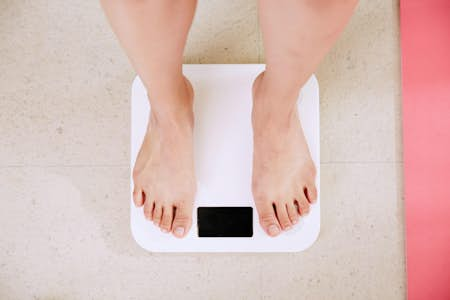What is a Couch to 5K plan? Why commit to Couch to 5K?
Would you rather binge-watch the latest Netflix series that everybody’s talking about, or run in your local half-marathon?
A couch potato will settle for the former any day. But what if you could become a fitter, healthier and slimmer person by just running a fraction of that distance? You don’t need to run a half-marathon to get these health benefits. You can start with a 5K. And who knows? You might one day be one of the runners in your local half-marathon, raising money for charity.
Running can be hard on your joints and tendons, so you need to condition yourself before running long distances. A good couch to 5K plan is a comprehensive training guide geared towards those who have been living a sedentary lifestyle and who need to condition their body and joints before running the full 5-kilometre distance.
There are mixed opinions about the effects of running, with some experts arguing that you should avoid it because it wears your joints out, and others who believe the health benefits far outweigh any potential drawbacks. By following our couch to 5k plan, you can reduce your risk of chronic illnesses such as diabetes, heart disease and obesity.
Ready to transform your life? Whether you're looking for a new pair of running shoes or some shiny home gym equipment, you can find everything you need to fuel your fitness journey with our partner brands.
Over 50s Couch To 5K training programme overview
The majority of couch to 5k training programmes target those who aren’t over 50. In this guide, we outline a 12-week training plan which is tailor-made for someone over 50. The amount of running and walking you do each week gradually increases, and you’ll be guided towards completing a 5K run on the last week. At the end of it, you should be fitter, stronger, and much healthier. You won’t want to go back!
You will complete one interval-style run in the first of three weekly training sessions, where you alternate between running and walking. For the second session, you will either complete fewer intervals than the first session or just walk - do whichever you are capable of. In the third session, you will be walking a set distance, which gradually builds up to running longer distances.
You will also complete a strength training routine twice-per-week to condition your joints and help you avoid injury. On every 4th week you will not do your usual training programme, but instead take an active rest, where you will do cycling or swimming. An active rest gives your joints and muscles time to rest and recuperate.
Couch to 5K running and training plan
Do your best to try and stick to the programme!
You must rest for at least one day in between sessions.
Do the strength training exercises after your running or walking.
To avoid injury, it’s imperative you do the warm up and dynamic stretches before each session and follow the cool down procedure after your workout.
Couch to 5k: Warm up
Warm up by walking quickly for the amount of time indicated, then complete the dynamic stretches detailed below. Before starting the interval training, rewarm yourself by walking briskly for the stated time.
Dynamic stretches
Dynamic stretches lubricate and improve the mobility of your joints. They are not the same as static stretches, which are now widely believed to be unnecessary for a warm up, and can even increase your risk of injury.
Instead, after you have warmed up in each training session, follow the instructions below for the dynamic stretches.
Leg swings
With one hand, hold onto something sturdy like a pole or a tree and swing one leg backwards and forwards. Use the momentum your leg gains to keep it moving. Don’t swing your leg too far forwards or backwards - you don’t want to pull or tear a muscle. Complete 10 repetitions (reps) on each leg.
Quad and hip flexor stretching
Like with the leg swings, you might need to hold onto something for support for this stretch. From a standing position, bring one foot up and behind you, pulling it toward your bottom. Don’t hold the stretch; instead, drop your foot back down to the floor and repeat the same movement for your other leg. Repeat 10 times on each leg.
Standing heel lifts
Standing with your feet about shoulder-width apart, stand up onto the balls of your feet and then slowly lower your heels to the floor. Try to control the movement when going back down. Do 10 reps.
Dynamic calf stretches
With a static calf stretch, you would typically bring one leg behind you, straighten it, and push your heel into the floor. To make it dynamic, instead of holding the stretch and once you have pushed your heel into the floor, switch to the other leg. Alternate between legs for a total of 10 reps on each leg.
Cool down
After each running or walking session, cool down by walking slowly for the amount of time indicated.
Cool down stretches
Stretch your quads, hamstrings and calves. Hold each stretch for 20-30 seconds.
| WEEK | SESSION 1 | SESSION 2 | SESSION 3 |
| 1 | Warm up by walking quickly for 5 minutes, rewarm, and then alternate between 20 seconds of slow running and 3 minutes of walking (1 interval), for a total of 5 intervals. Cool down by walking slowly for 2 minutes. Complete 2 sets of the strength training exercises and follow the cool down stretches after your workout. Hold each stretch for 20-30 seconds. | Either: Alternate between 20 seconds of running and 3 minutes of walking for a total of 10 minutes, and up to a maximum of 3 intervals. For example, you could just do 1 interval and then walk for the remainder of the time left. Choose a number of intervals that you are comfortable with, but don’t do more than 3. OR Walk quickly for 10 minutes. Make sure you warm up, stretch and cool down. | Walk for 2 Km. Complete the same strength training exercises and number of sets as session one. |
| 2 | Warm up by walking quickly for 5 minutes, rewarm, and then alternate between 40 seconds of slow running and 3 minutes of walking. Complete 5 of the above interval pattern. Cool down by walking slowly for 2 minutes. Do 2 sets of the strength training exercises and follow the cool down stretches after your workout. Hold each stretch for 20-30 seconds. | Either: Alternate between 40 seconds of running and 3 minutes of walking, up to a maximum of 3 intervals. OR Walk quickly for 11 minutes. Warm up, stretch and cool down. | Walk for 3 Km. Complete the same strength training exercises and number of sets as session one. |
| 3 | Warm up by walking quickly for 5 minutes, rewarm, then alternate between 60 seconds of slow running, and 2 minutes and 30 seconds of walking. Do 6 of the above interval pattern, which will take you to a total of 21 minutes. Cool down by walking slowly for 2 minutes. Do 3 sets of the strength training exercises and follow the cool down stretches after your workout. | Either: Alternate between 60 seconds of running, and 2 minutes and 30 seconds of walking, up to a maximum of 4 intervals. OR Walk quickly for 14 minutes. Warm up, stretch and cool down. | Walk for 4 Km. Complete the same strength training exercises and number of sets as session one. |
| 4 - active rest week | Recreational swimming or cycling. | Recreational swimming or cycling. Complete the same strength training exercises and number of sets you did for session one on week 3. | |
| 5 | Warm up by walking quickly for 6 minutes. Stretch, and rewarm yourself this time for 2 minutes, then alternate between 1 minute and 30 seconds of slow running, and 2 minutes and 30 seconds of walking. Do 6 of the above intervals, for a total of 24 minutes. Cool down by walking slowly for 2 minutes. Do 3 sets of the strength training exercises and follow the cool down stretches after your workout is complete. | Either: Alternate between 1 minute and 30 seconds of running, and 2 minutes and 30 seconds of walking, up to a maximum of 4 intervals. OR Walk quickly for 16 minutes. Warm up, stretch and cool down. | Walk for 5 Km. Complete the same strength training exercises and number of sets as session one. |
| 6 | Warm up for 6 minutes, stretch, and rewarm yourself for 2 minutes, then alternate between 2 minutes of slow running and 2 minutes of walking. Complete 6 of the above interval pattern, for a total of 24 minutes. Cool down by walking slowly for 2 minutes. Do 3 sets of the strength training exercises and follow the cool down stretches after your workout is complete. | Either: Alternate between 1 minute and 30 seconds of running, and 2 minutes of walking, up to a maximum of 6 intervals. OR Walk quickly for 21 minutes. Warm up, stretch and cool down. | Run for 1 Km. Complete the same strength training exercises and number of sets as session one. |
| 7 | Warm up for 6 minutes, stretch and rewarm yourself for 2 minutes, then alternate between 3 minutes of slow running, and 1 minute and 30 seconds of walking. Do 5 of the above interval pattern, for a total of 22 minutes and 30 seconds. Cool down by walking slowly for 2 minutes. Do 3 sets of the strength training exercises and follow the cool down stretches after your workout is complete. | Either: Alternate between 2 minutes of running, and 2 minutes of walking, up to a maximum of 5 intervals. OR Walk quickly for 20 minutes. Warm up, stretch and cool down. | Run for 2 Km and walk for 3 Km. Complete the same strength training exercises and number of sets as session one. |
| 8 - active rest week | Recreational cycling or swimming | Recreational cycling or swimming | |
| 9 | Warm up for 6 minutes, stretch, and rewarm yourself for 2 minutes, then alternate between 4 minutes of slow running, and 1 minute and 30 seconds of walking. Complete 5 of the above interval pattern, for a total of 27 minutes and 30 seconds. Cool down by walking slowly for 2 minutes. Do 4 sets of the strength training exercises. Stretch after your workout is complete. | Recreational cycling or swimming | Run for 3 Km and walk for 2 Km. Note down how long it takes you to complete the whole distance. Complete the same strength training exercises and number of sets as session one. |
| 10 | Warm up by walking quickly for 8 minutes, stretch, and after rewarm yourself by walking quickly for another 3 minutes, then alternate between 4 minutes of slow running, and 1 minute of walking. Do 6 of the above intervals, for a total of 30 minutes. Cool down by walking slowly for 2 minutes. Do 4 sets of the strength training exercises. Stretch after your workout is complete. | Recreational cycling or swimming | Run for 3 Km and walk for 2 Km. Try to beat your time from last week! Complete the same strength training exercises and number of sets as session one. |
| 11 | Warm up for 8 minutes, stretch, and after rewarm yourself by walking quickly for another 3 minutes, then alternate between 5 minutes of slow running and 1 minute of walking. Do 6 of the above intervals, for a total of 36 minutes. Cool down by walking slowly for 2 minutes. Complete 4 sets of the strength training exercises. Stretch after your workout is done. | Recreational cycling or swimming | Run for 4 Km and walk for 1 Km. Complete the same strength training exercises and number of sets as session one. |
| 12 | Warm up for 8 minutes, stretch, and after rewarm yourself by walking quickly for another 3 minutes, then alternate between 8 minutes of slow running, and 1 minute of walking. Do 4 of the above intervals, for a total of 36 minutes. Cool down by walking slowly for 2 minutes. Do 4 sets of the strength training exercises. Stretch after your workout is complete. | Recreational cycling or swimming | RUN 5K! |
Couch to 5K program: Strength training exercises
These exercises will help towards conditioning your muscles and tendons for when you regularly start to run long distances. Do these regularly to prevent injury.
Squats
Begin with your feet at about shoulder-width apart, bend your legs and lower yourself down while leaning forwarding slightly and keeping your spine neutral. You can put your arms out in front of you to keep yourself stable. Once your hips are at around a 45-degree angle, push your heels into the floor and straighten your legs while bringing your hips forward. 10 reps counts as one set.
Lunges
With your feet shoulder-width apart, take a big step forward with one leg and bend at the knee until your leg is about parallel with the floor, and while bending your other leg slightly. Try to shift your weight forward a bit on the way down, and then drive yourself back up to the resting position by pushing your front heel into the floor. Change legs and repeat. 10 reps on each leg counts as one set.
Russian twists with an exercise ball
Sitting down on a mat with your legs out in front of you and your knees bent, hold the ball in your hands in front of you. Rotate your upper body to one side and bang the ball down on the floor to engage your core. Keep your spine neutral and rotate from your hips, then swing your arms over to the other side, banging the ball down again. That’s 1 repetition. Do 12 reps.
Back extensions
Lying on your front with your hands under your chin and elbows bent, gently raise your torso off the floor a little and feel the exercise working your lower back. Do 10 reps.
Crunches
While lying on your back with your knees bent, your hands on either side of your head and your elbows straight, pretend you have a tennis ball between your chin and your chest, so that when you crunch up with your abs, your chin doesn’t move. It can help if you stare up at a spot on the ceiling behind you. Complete 12 reps.
For some extra strength and conditioning exercises for runners, take a look at the YouTube video below:
Exercise after completing the Couch to 5K program
Well done if you managed to complete the above training programme and run the whole 5K! Now that you are capable of running longer distances, you should have lost weight, and reduced your blood pressure and resting heart rate. It’s important that you don’t go back to being a couch potato. Strive to run longer distances and stay fit for life.









